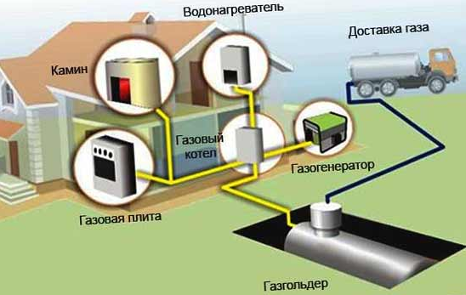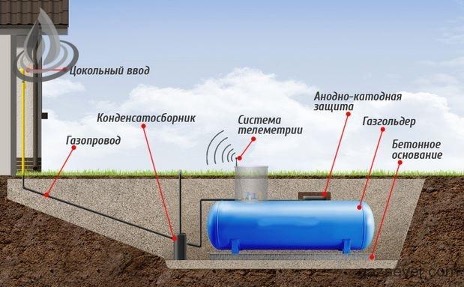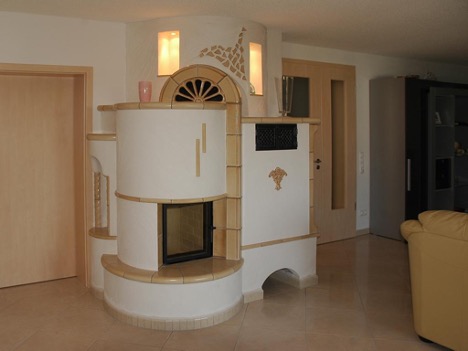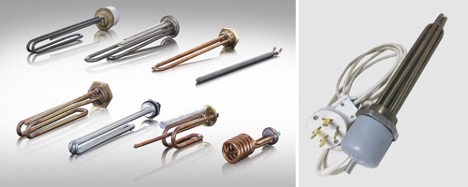Installing a gas tank on the site: what is it for, how does it work
A gas holder is a specialized tank for storing liquefied gas, which provides a continuous supply of gas to the heating system, gas stove or water heater. From this article you will learn what a gas tank is for and how to properly care for it.

The content of the article
How does a gas tank work?
These units are designed to store gas in liquefied form under high pressure. This allows a large volume of gas to be stored in a relatively small tank, ensuring efficient use of space. When gas is needed for use, it changes from a liquefied state to a gaseous state and is supplied through pipelines to consumers such as heating systems, water heaters or gas stoves.
One of the key functions of a gas tank is maintaining and regulating gas pressure in the system. This is done using pressure reducers, which reduce the high pressure of liquefied gas to a level suitable for domestic use. Pressure regulation ensures gas supply is safe and efficient and helps prevent pressure fluctuations that could cause leaks or damage to the system.
Thermoregulation in a gas tank is critical for its efficient operation. At low temperatures, the liquefied gas may not evaporate properly, reducing the efficiency of the system.Some gas tanks are equipped with heating systems to maintain the optimal gas temperature and ensure its uniform evaporation and supply.
Main components of a gas tank:
- A tank where liquefied gas is stored.
- Pressure reducers that reduce gas pressure to a safe level.
- A pipeline system through which gas is transported to consumers.
- Sensors and measuring instruments that monitor gas levels and pressure.
- Heating systems that maintain optimal gas temperature.
Stages of installing a gas tank
Installing a gas tank in a private home requires careful planning and compliance with technical standards. The process can be divided into several stages:
- The location of the gas tank on the site must comply with safety standards.
- It is necessary to provide a reliable and stable base for the gas tank.
- Installation of a gas holder includes connecting to the home gas supply system and checking for leaks.
- Checking the system for functionality and safety.

Rules for placing a gas tank on a site
It is important to consider the minimum permissible distances between the gas tank and residential buildings, as well as other objects on the site. This will ensure safety for both the residents of the house and neighboring areas. It is also necessary to take into account the accessibility of the gas tank for maintenance and refueling, which includes the possibility of access of specialized equipment.
In addition to compliance with safety standards, the location of the gas tank on the site must take into account the operating conditions. The ideal place for a gas tank is an area protected from direct sunlight and significant precipitation, which prevents overheating or freezing of the gas.It is also important to locate it away from open flames and areas of high vibration to minimize the risk of explosion or gas leakage.
When placing a gas holder, it is also important to consider environmental factors. It is necessary to exclude the possibility of contamination of soil and groundwater in the event of a gas leak. Therefore, it is recommended to avoid installing a gas holder in close proximity to reservoirs, wells and agricultural land. This will help prevent negative impacts on the environment and comply with environmental regulations.
Advantages and disadvantages
Installing a gas tank means ensuring an autonomous gas supply, but it is important to consider both the advantages and possible disadvantages of this solution.
Advantages:
- Autonomy and independence from central gas networks.
- Saving on gas costs when purchasing large quantities of gas.
- Possibility of use in remote areas where there is no centralized gas supply.
Flaws:
- The need for regular maintenance and refueling.
- High installation and installation costs.
- Occupancy restrictions related to safety standards.
Required annual maintenance steps
This is a key process that ensures the gas tank is used safely and efficiently. Here are the basic steps you must follow:
- Inspect for damage, corrosion or leaks on both the external and internal surfaces of the gas tank. Pay attention to the condition of the coating and possible deformations.
- Carefully check all valves, pressure reducers and measuring instruments for functionality and tightness.
- Make sure gas level sensors, emergency shutdown systems and other safety devices are working properly.
- Remove contaminants, check and, if necessary, replace filters and other consumables.
- Use special methods (eg testing with foaming solutions) to detect gas leaks.
By following these steps, you will help prevent accidents, extend the life of your equipment, and help ensure trouble-free operation.
Conclusion
Installing a gas holder in a private home is an effective solution for ensuring autonomous gas supply. Correct selection, installation and compliance with operating rules will ensure safety and comfort in using a gas tank on your site.





